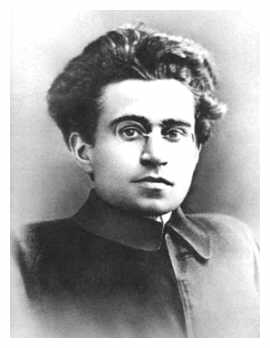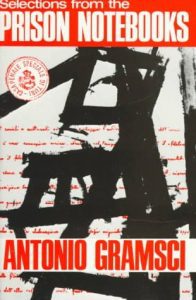
Antonio Gramsci was an Italian Marxist intellectual and politician who can be seen as the perfect example of the synthesis of theoreticians and politicians. He was not only a thinker involved in the revision and development of Marxism, who wrote in several socialist and communist Italian journals, but also a politically active militant. The fascist government of Benito Mussolini imprisoned him between 1926 and 1937.

Gramsci’s political activities were not only related to his publications. His actions as a politician, activist, and intellectual were consistent with his ideas. He believed that the proletariat needed “organic” intellectuals (described below) to become a hegemonic class, and during his lifetime, he himself assumed such a role. As a member of the Socialist Party and, later, the Communist Party, he wrote in several journals seeking to reach a wide audience and indoctrinate it in the basic ideas and principles of the proletariat and social struggle. While incarcerated, and away from mass media, he wrote his most celebrated and influential theoretical contributions to Marxist theory. Among these, two concepts would become most important to scholars of different disciplines: hegemony and historical bloc. In what follows, this piece will concentrate on the concept of hegemony in Gramsci and the sources upon which he built it.

Gramsci developed the notion of hegemony in the Prison Writings. The idea came as part of his critique of the deterministic economist interpretation of history; of “mechanical historical materialism.” Hegemony, to Gramsci, is the “cultural, moral and ideological” leadership of a group over allied and subaltern groups. This leadership, however, is not only exercised in the superstructure –or in the terms of Benedetto Croce– is not only ethico-political, because it also needs to be economic, and be based on the function that the leading group exercises in the nucleus of economic activity. It is based on the equilibrium between consent and coercion. Gramsci first noted that in Europe, the dominant class, the bourgeoisie, ruled with the consent of subordinate masses. The bourgeoisie was hegemonic because it protected some interests of the subaltern classes in order to get their support. The task for the proletariat was to overcome the leadership of the bourgeoisie and become hegemonic itself.
Although for some scholars the Gramscian concept of hegemony supposes the leading role of the dominant class in the economy, Gramsci believed that the leading role of the dominant class must include ideology and consciousness, that is, the superstructure. The location of cultural, ideological, and intellectual variables as fundamental for the proletariat in its struggle to become a leading class is Gramsci’s main contribution to Marxist theory. With it, the Italian intellectual sought to undermine the economic determinism of historical materialism. He was acknowledging that human beings had a high degree of agency in history: human will and intellect played a role as fundamental as the economy.
Even though Gramsci was harshly critical of what he called the “vulgar historical materialism” and economism of Marxism, as a Marxist he assumed the fundamental importance of the economy. At this point, however, economic determinism seems to be a problem for the Gramscian concept of hegemony, and the ways the proletariat can become hegemonic. According to Gramsci, only a hegemonic group that has the consent of allies and subalterns can start a revolution, which would mean that it is necessary to establish proletarian hegemony before the socialist revolution.
However, how can the proletariat have a dominant position in the world of economy before the socialist revolution? How could the proletarians dominate the economy if the bourgeoisie is the class that controls the means of production and, therefore, controls the economy? Here Gramsci proposes that, in order to achieve a hegemonic position, the proletariat must ally with other social groups struggling for the future interests of socialist society, like the peasantry. The idea was to establish a new historical bloc (one that breaks the order established by the capitalist structure and the political and ideological superstructures on which the bourgeoisie relies) and a new collective will of the subaltern classes. This, in words of Im Hyug Baeg, can be interpreted as “counter-hegemony” something that “is not a real hegemony in strict sense, but economic, political and ideological preparations for hegemony before overthrowing capitalism or before winning state power” (Hyug Baeg, 142).

One of the ways the proletariat must undertake such a task is through “organic intellectuals,” which for Gramsci, “are the dominant group’s ‘deputies’ exercising the subaltern functions of social hegemony and political government.” Their “function in society is primarily that of organizing, administering, directing, educating or leading others.” These specialized cadres, formed both in the working-class political party and through education, had the duty of organizing, administering, directing, educating or leading others. The formation of a national-popular collective is not an autonomous process, nor is the will of that collective. The organic intellectuals, who must be unrelated to the intellectuals of the bourgeoisie, must organize and mediate in the formation of the national-popular collective will.
Sources and Further reading:
Antonio Gramsci, The Antonio Gramsci Reader, eds. David Forgacs and Eric Hobsbawm (New York: NYU Press, 2000).
Carlos Emilio Betancourt, “Gramsci y el concepto del bloque histórico”. Historia Crítica. Julio-Diciembre 1990, pp. 113-125.
Derek Boothman, “The Sources for Gramsci’s Concept of Hegemony,” Rethinking Marxism: A Journal of Economics, Culture & Society (2008), 20:2, pp. 201-215.
Im Hyug Baeg, “Hegemony And Counter-Hegemony In Gramsci.” Asian Perspective, Vol. 15, No. 1 (Spring-Summer 1991), pp. 123-156.
Gramsci Monument, Bronx, New York
The views and opinions expressed in this article or video are those of the individual author(s) or presenter(s) and do not necessarily reflect the policy or views of the editors at Not Even Past, the UT Department of History, the University of Texas at Austin, or the UT System Board of Regents. Not Even Past is an online public history magazine rather than a peer-reviewed academic journal. While we make efforts to ensure that factual information in articles was obtained from reliable sources, Not Even Past is not responsible for any errors or omissions.




